Patio covers make beautiful additions to the home. They can increase your home’s value and extend your living space to the outdoors, creating new areas for entertaining and enjoying the day. When considering the installation of a patio cover, you need to start by deciding on the type of cover you prefer.
There are many patio covers to choose from, each with its own set of advantages and disadvantages. To keep it simple, this guide will review the eight most popular types, explaining precisely what you need to know about each to decide which best suits your needs. By the end of this article, you will know exactly what patio cover will make you fall in love with your backyard again, and you will be on your way to having it installed in your home.
What is a Patio Cover?
A patio cover is the perfect addition to your home if you have an outdoor space that seems unusable because it is in direct sunlight or exposed to harsh weather conditions. Patio covers protect against the elements, enhance the beauty of your home, and create a functional, enjoyable outdoor living space all year round. A patio cover not only looks great and provides additional entertaining space but can also increase your home’s value and attract potential buyers.
There are many types of patio covers that you can get to add a sense of style and function to your outdoor space. From aluminum solid covers to lattice pergolas, this guide will take you through everything you need to know about each style to pick the perfect one.
Different Types of Patio Covers
Aluminum Patio Covers
Pros: Durable, low maintenance
Cons: Can dent and need replacing
Aluminum is one of the best materials for constructing the perfect patio cover. It is incredibly durable and requires very little maintenance, meaning you will have plenty of time to sit and enjoy the outdoors instead of repairing and cleaning your patio cover. Aluminum can be easily customized to fit your style and can be painted in your favorite colors. The material’s light weight also means that you can save on professional installation by doing it yourself or by needing less crew to help you.
The only downside to this metal is that it is possible to dent it in severe weather. However, it will hold up perfectly for years and years in every other condition, making it the best option for the average person. Even the paint used on these aluminum sheets will last longer than many of the different materials on this list. This is the best option if you are looking for a durable, customizable material to easily install yourself.
Vinyl Covers
Pros: Customizable, easy to install
Cons: Need to be replaced quicker than other materials
Vinyl covers are a fantastic option if you want something that looks good while being quick and cheap to set up. As they are such a lightweight material, they are the perfect option as a DIY patio cover if you do not want to go through the entire process of hiring an installation crew. Installing a vinyl cover can be a quick weekend project that genuinely adds to your outdoor space.
The downside is that vinyl easily warps and fades in the sun, which means it needs constant maintenance or even replacement after a while. It is also not generally the most durable material, not holding up well in harsher weather conditions like rain and snow. Therefore, vinyl is not the best option for those living in areas with variable weather who wish to use their patio year-round.
Solid Patio Covers
Pros: Require little maintenance, offers complete shade and weather protection
Cons: No sunlight passes through
If you want to spend most of your time outdoors, this is the best option for you. Solid patio covers allow for full sun and weather protection, which means you can enjoy your patio every day of the year, even when it is raining hard. Unfortunately, if you love to tan or grow plants on your patio, this option prevents sun rays from reaching you, so it’s best to stay away.
Lattice Covers
Pros: Allows partial sunlight
Cons: does not allow protection from other types of weather
Lattice covers are becoming increasingly popular for outdoor patios. This option is perfect if you live in a dry, moderately warm climate, as you get all the benefits of partial sunlight without needing to protect yourself from the elements. Lattice covers are not ideal for backyards that regularly experience harsh weather like snow or heavy winds, but they offer a stylish and functional addition in milder climates.
Pergolas
Pros: Stylish and functional
Cons: Only a moderate amount of sun and rain protection
Pergolas are a patio cover style with structural support beams and are usually made with a flat, latticed roof. They are perfect if you want to add a true sense of style to your patio. Pergolas are ideal for creating a cozy patio space with beautiful columns and an attractive roof. They are not the best type of patio cover to use if you need complete weather protection, as they usually let in the sunlight through the roof, giving a glowy look to your entertaining space.
Awnings
Pros: Retractable options for flexible sun control
Cons: Partial sunlight, not the most stylish option
Living in a changeable climate often means you must compromise on how you can enjoy your outdoor space. Using a retractable awning allows you to approach each day flexibly and get the best use out of your backyard no matter what is thrown at you. With an awning, you get the best of both worlds: having a patio cover when you need it and an open space when you don’t.
A fixed awning can also be a great option if you are looking for just the right amount of shade while still allowing air and sunlight to flow through. Unfortunately, awnings do not fit everyone’s ideal aesthetic for their backyard, meaning they are a less desirable option for people mainly interested in style.
Thatched Roof Covers
Pros: Perfect for a tropical aesthetic
Cons: Expensive
Thatched roof covers are beautifully and intricately crafted to provide a solid cover that protects from sun and weather. Because of their densely packed construction, these covers are highly durable and can last up to 60 years. To achieve this effect, they need to be properly made with effective drainage and long-lasting material. For this reason, we do not recommend attempting a thatch roof DIY project; it’s best left to professionals.
As this is a highly sought-after skill set, the costs for this roof can add up. Depending on your location, it might be challenging to find someone skilled in constructing these types of roofs. Additionally, thatched roof covers are susceptible to fire, so do not choose this option if you live in a particularly dry area.
Canopies
Pros: Extremely versatile
Cons: Not that durable or rugged against elements.
Canopies are incredibly versatile, which means they can be used in many different ways for many different purposes. For example, if you have a commercial property that needs shade in the summer months, this is a great solution that is easy to set up and attractive to potential customers. However, canopies are equally stunning in residential areas, where they create open outdoor living spaces for the whole family to enjoy. This type of canopy cover is ideal if you only need it for a few months each year and want to protect it from dirt and grime during the off-season.
Factors to Consider When Choosing Patio Covers
There are many factors to consider when choosing a patio cover, including material, climate, and project complexity. Each of these factors will affect the time, money, and effort required to install your patio cover and create a beautiful addition to your home.
Material Choices
Choosing the material for your patio cover is the most critical decision for your new outdoor addition. Your choice of material will determine everything from how expensive your project will be to how often you need to maintain your cover. We have compiled the most popular choices below to give you an overview of available options.
- Wood: This option is initially relatively low-cost but requires more maintenance. Depending on your local weather conditions, you may need to repair or refinish your wood at least once a year.. Wood also allows a high level of customizability, with the choice of wood and stain entirely up to you.
- Metal: Although this option is more expensive, it provides better protection from the weather, including harsh sunlight and strong winds.
- Vinyl: This is the cheapest option and the perfect choice if you are considering a DIY build. However, it is not the most durable material and may need to be replaced or taken down in heavy weather conditions.
- Thatch: Thatch is a beautiful and durable option for your outdoor patio cover, especially if you are trying to curate a tropical feel for your backyard. However, this material needs regular inspections to be maintained correctly, and depending on where you live, it may be challenging to find a thatcher to do this.
Climate Considerations
Where you live greatly determines what type of patio cover you should get if your home experiences regular snowfall, less durable materials like vinyl and wood may not be the best options.
The type of patio cover you get will also depend on your climate. Lattice covers work best in places with mild summers where some sun is welcome, while a retractable awning is better for areas with more variable weather. Keep your year-round climate conditions in mind when considering what will work best for you and your patio.
Installation Complexity
Different types of patios will require different levels of skill, effort, and money to achieve. Vinyl covers are the best option for DIY work as the material is cheaper and easy to set up, even with minimal DIY skills.
Options like pergolas or more difficult materials like thatch and wood may require a skilled craftsman’s help to set everything up correctly. This is especially true if you plan to create a more intricate design with features like built-in lights or a firepit. You may even need a designer who specializes in patio covers to look at your specific needs and wants and give you the perfect addition to your outdoor space.
Patio Cover Maintenance and Durability
Maintaining your patio cover is essential if you want to maximize its lifespan and effectiveness. Your maintenance routine will vary depending on the type of cover and material used, but here are our top three tips for keeping your new patio cover looking beautiful.
- Inspect regularly: To keep your patio cover in top condition, inspect it regularly for any parts that need repair or replacement. This means checking the cover and ensuring that any additional fixtures like lighting, firepits, or structural beams all look as they should. Address any issues or signs of wear and tear immediately to prevent them from worsening.
- Clean frequently: Clean your patio cover every three to four months, or more often if it gets dirty quickly, such as in dusty or rainy environments. Cleaning methods will vary depending on the style and material of your cover, but generally, use a mild, non-chemical cleaning solution to remove stains and mildew.
- Address Rust Immediately: Even if your patio cover is not metal, some parts, like support beams, might be. If you spot rust during your inspections, address it immediately with a rust-removing solution. If you leave it too long, this could become a major problem, which you will need to call outside help to fix.
Cost Analysis
The cost of your new patio cover can vary significantly depending on the type you choose. Most patio covers cost between $4,000 and $25,000, with an average price of $6,500. Your cheapest option is a vinyl cover, which usually costs around $3,000 but can be much less if you decide to do much of the labor yourself. The most expensive option is a pergola, which costs up to $25,000 based on materials. Aluminum covers and awnings will fall on the more affordable side of the typical range, while thatch and wooden lattice covers will tend to be more expensive.
Keep in mind that you will also incur maintenance costs for your patio cover. Materials like wood, thatch, and vinyl need regular inspection and maintenance. Additionally, more intricate designs like lattice covers or pergolas may require more extensive cleaning compared to simpler styles.
Ultimately, a patio cover will add massive value to your house, not just financially if you are trying to save but also in the wealth of memories you can share in your new outdoor entertainment space. If you eventually decide to sell your home, a patio cover can offer an impressive 80% return on investment.
Conclusion
There is a lot to consider when deciding to get a patio cover. The benefits of this addition are enough to push anyone with an outdoor space to consider it. Extending your living space and creating a beautiful outdoor fixture perfect for entertaining is an extremely attractive idea, which is more than possible for anyone interested. This guide has explained what to expect if you choose to install a patio cover, from the different types available to the factors to consider before making an investment.
We encourage anyone interested in installing a patio cover to consult experts to discuss personal needs and property specifics to determine the exact cost.







